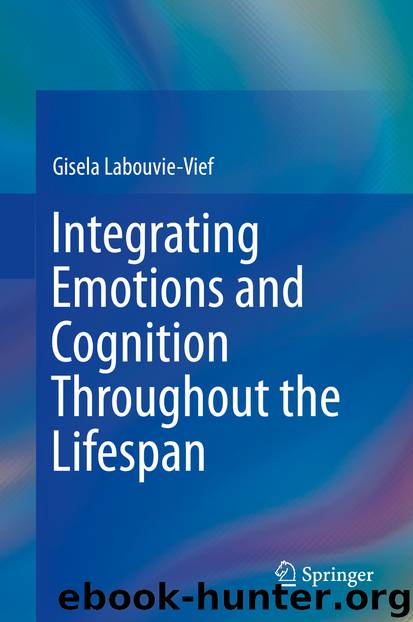Integrating Emotions and Cognition Throughout the Lifespan by Gisela Labouvie-Vief

Author:Gisela Labouvie-Vief
Language: eng
Format: epub
Publisher: Springer International Publishing, Cham
Self-Conscious Emotions and Morality. As suggested by Piaget’s above-cited quote, then, the awareness of self brings about a restructuring of the child’s emotions, and it does so in several ways. One of those ways is, that out of the simple and basic, automatic and “ancestral” emotions proposed by Darwin, more complex emotions can arise. These more complex emotions are not simply activated as a result of particular external situations, but add and include cognitive evaluations of the situation. Becoming aware of being observers as well as objects of observation, children now become aware of relatively new emotions that reflect this awareness of being evaluated. These self-conscious emotions (Lewis & Haviland-Jones, 2000) comprise feelings such as embarrassment, shame, or guilt in situations that lead individuals to believe that real or imputed evaluations of others are negative; if, on the other hand, the belief is that others judge the self positively, pride is likely to be the result. The interpersonal side of emotions, therefore, moves to the fore of the child’s awareness, since all of these emotions attest to the fact that children now begin to relate themselves to, and internalize, social standards and rules of how one should, or is expected to, behave. It is for that reason, in effect, that Piaget invokes the term of moral emotions.
What makes self-conscious emotions have moral implications and meanings is the fact, that they motivate and incorporate the standards of acceptable behavior children have already realized. Moral emotions hence are evoked by self-reflection and self-evaluation on oneself and one’s action; in this way they serve affective consequences that are based on an evaluation of the ethical nature of one’s behavior, such as conformity to standards, propriety, and consequences for others (Tangney, Stuewig, & Mashek, 2007). The two self-conscious emotions of shame and guilt, both involve a negative evaluation of the self, but of the two, shame is considered the more problematic one, since it involves a negative evaluation of the self in the global way; guilt, in contrast, is considered less severe because it involves a negative evaluation of a specific behavior, rather than the global self. Understandably, shame is a much more painful emotion than guilt, because in shame the core of one’s self appears to be in question, whereas in the case of guilt it is only the specific behavior that is being judged. In shame, one feels a sense of shrinking and wanting to hide, of worthlessness and powerlessness, and one would like to deny, hide, and escape. Guilt is considered less painful because it is only a specific behavior that is being judged and not the entire self; moreover, guilt can be repaired by engaging in some kind of action to repair the act through apologies or otherwise making up for an offensive action.
The emergence of self-conscious emotions underscores Kagan (1981) already cited finding that young children begin to be aware and recognize external standards (Lagatutta & Thompson 2007; Tracy, Robins, & Tangney, 2007). Precursors of this awareness are, nevertheless, already evident before the advent of a more advanced sense self-consciousness.
Download
This site does not store any files on its server. We only index and link to content provided by other sites. Please contact the content providers to delete copyright contents if any and email us, we'll remove relevant links or contents immediately.
The Art of Coaching Workbook by Elena Aguilar(50044)
Trainspotting by Irvine Welsh(20948)
Twilight of the Idols With the Antichrist and Ecce Homo by Friedrich Nietzsche(18268)
Fangirl by Rainbow Rowell(8760)
Periodization Training for Sports by Tudor Bompa(7891)
Change Your Questions, Change Your Life by Marilee Adams(7324)
This Is How You Lose Her by Junot Diaz(6403)
Asking the Right Questions: A Guide to Critical Thinking by M. Neil Browne & Stuart M. Keeley(5322)
Grit by Angela Duckworth(5265)
Red Sparrow by Jason Matthews(5169)
Paper Towns by Green John(4756)
Room 212 by Kate Stewart(4706)
Ken Follett - World without end by Ken Follett(4413)
The Sports Rules Book by Human Kinetics(4048)
Housekeeping by Marilynne Robinson(4019)
Double Down (Diary of a Wimpy Kid Book 11) by Jeff Kinney(3878)
Papillon (English) by Henri Charrière(3873)
Exercise Technique Manual for Resistance Training by National Strength & Conditioning Association(3757)
The Motorcycle Diaries by Ernesto Che Guevara(3756)
